Samsung Galaxy Note 3 Review
by Brian Klug on October 1, 2013 9:00 AM EST- Posted in
- Smartphones
- Samsung
- Mobile
- Android 4.3
- galaxy note 3
CPU Performance
The original Note I played with was based on Qualcomm’s APQ8060 platform with MDM9200 baseband (the so-called Fusion 2 platform) and was for its time a pretty awesome piece of kit, combining LTE and a dual core SoC. The Note 2 I played with next was based on Samsung’s own Exynos 4412 SoC with quad core Cortex A9 at 1.6 GHz and Mali–400MP4 GPU. For the Note 3, I’m looking at a T-Mobile variant (SM-N900T if you want to be exact about it) which means it includes a Snapdragon 800 SoC, and Samsung has gone for the 2.3 GHz bin (really 2.265 GHz rounded up). Inside are 4 Krait 400 CPUs running at up to 2.3 GHz, and Adreno 330 graphics at up to 450 MHz, all built on TSMC’s 28nm HPM HK-MG process.
I should note that this is MSM8974 and not MSM8974AB which oddly enough one of Qualcomm’s customers already announced (Xiaomi for the Mi3) which boosts GPU clocks up to 550 MHz and the LPDDR3 memory interface up to 933 MHz, among a few other changes. I’ve confirmed that GPU clocks on the Note 3 are indeed maxing out at 450 MHz, and quite honestly it’s a bit early for 8974AB in the first place, though it wouldn’t surprise me to see Samsung eventually get that faster bin at some point and put it in something.
I should mention that the Note 3 (like many other Android devices - SGS4, HTC One) detects certain benchmarks and ensures CPU frequencies are running at max while running them, rather than relying on the benchmark workload to organically drive DVFS to those frequencies. Max supported CPU frequency is never exceeded in this process, the platform simply primes itself for running those tests as soon as they're detected. The impact is likely small since most of these tests should drive CPU frequencies to their max state regardless (at least on the CPU side), but I'm going to make it a point to call out this behavior whenever I see it from now on. Make no mistake, this is cheating plain and simple. It's a stupid cheat that most Android OEMs seem to be ok with and honestly isn't worth the effort. Update: Of our CPU tests only AndEBench is affected exclusively by Samsung's optimizations, the performance gain appears to be around 4%. Vellamo is gamed by all of the Snapdragon 800 platforms we have here (ASUS, LG and Samsung). None of this is ok and we want it to stop, but I'm assuming it's not going to. In light of that we're working with all of the benchmark vendors we use to detect and disable any cheats as we find them. We have renamed versions of nearly all of our benchmarks and will have uniquely named versions of all future benchmarks we use. We'll be repopulating our Bench data where appropriate.
CPU performance is honestly excellent. The Galaxy Note 3 is more or less the fastest Android smartphone we've tested up to this point. In the situations where we can do cross platform (OS/browser) comparisons, it isn't quite as fast as the iPhone 5s but in some cases it comes close.

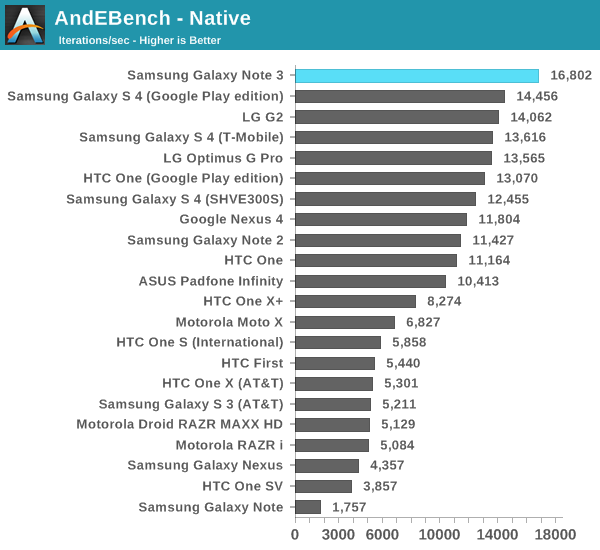
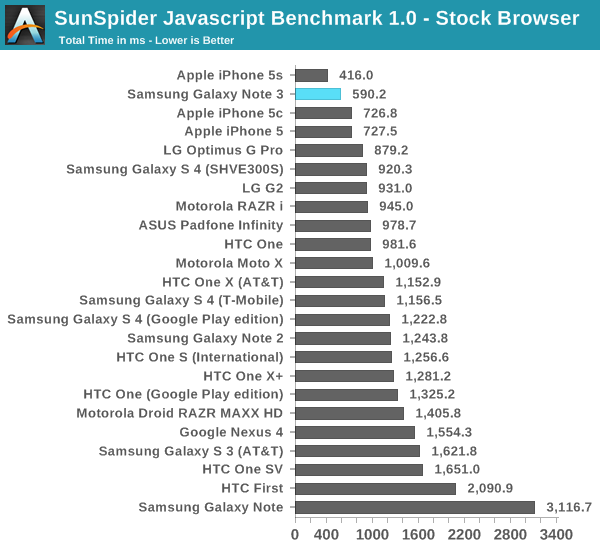

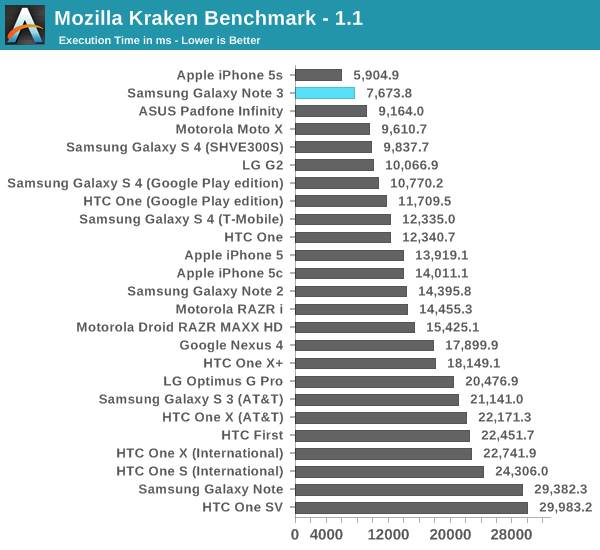
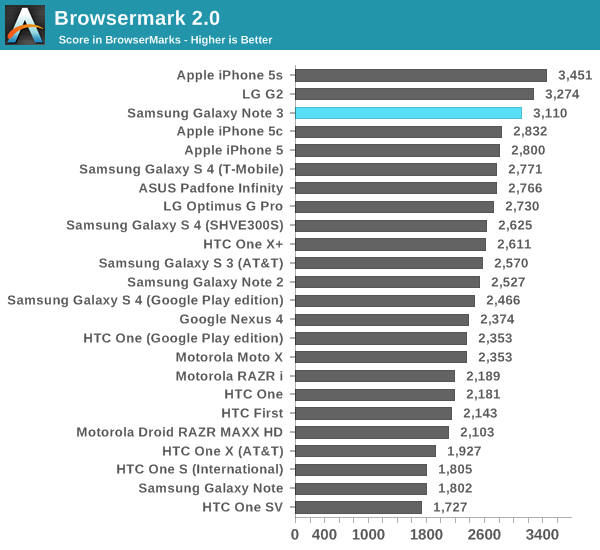
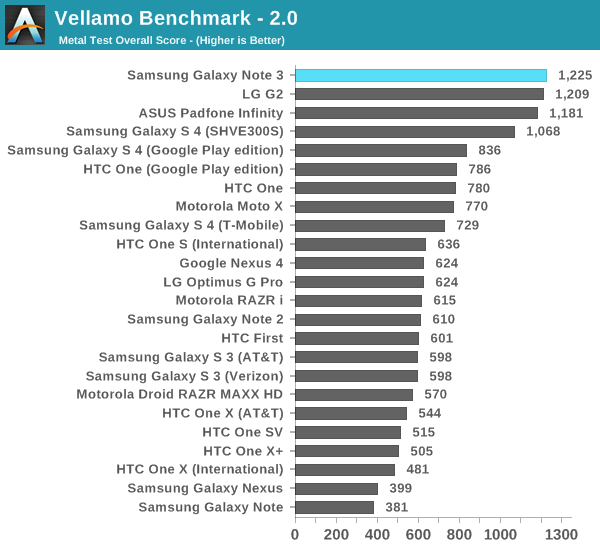

GPU Performance
Samsung definitely likes to win, and the Galaxy Note 3 walks away with the GPU performance crown in literally every single offscreen test we've got here. The onscreen tests are obviously governed by display resolution, but all things being equal the Note 3 manages to get the edge over the PowerVR G6430 in Apple's iPhone 5s. It's also interesting to note that the Galaxy Note 3 appears to outperform all other Snapdragon 800 smartphones we've tested thus far. There's a couple of potential explanations here. First, the Galaxy Note 3 is using newer drivers than any of the other S800 platforms we've tested:
Note 3: 04.03.00.125.077
Padfone: 04.02.02.050.116
G2: 4.02.02.050.141
Secondly, it's unclear how much the manual CPU DVFS setting upon benchmark launch is influencing things - although I suspect it's significant in the case of something like 3DMark.
Finally each manufacturer has the ability to define their own thermal limits/governor behavior, it could simply be that Samsung is a bit more aggressive on this front. We honestly haven't had enough time to dig into finding out exactly what's going on here (Samsung gave us less than a week to review 3 devices), but the end result are some incredibly quick scores for the Note 3. If I had to guess I'd assume it's actually a combination of all three vectors: drivers, high CPU frequencies and being more lenient with thermals.
Update: GFXBench 2.7 isn't affected by any optimizations here, but Basemark X and 3DMark are. We expect the Note 3's performance is inflated by somewhere in the 3 - 10% range. We're working on neutralizing this optimization across our entire suite.

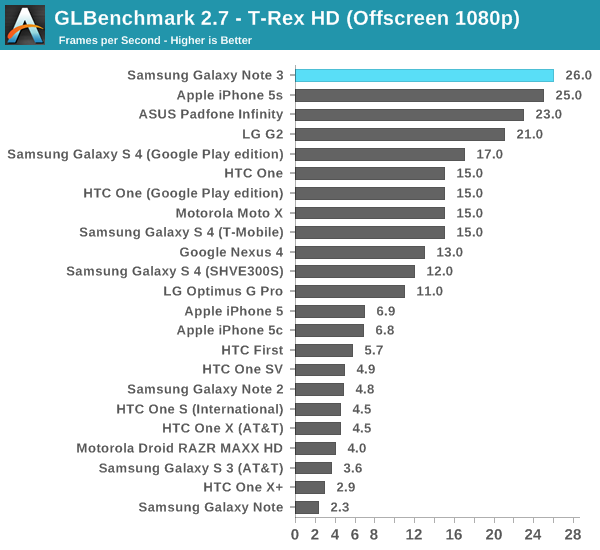
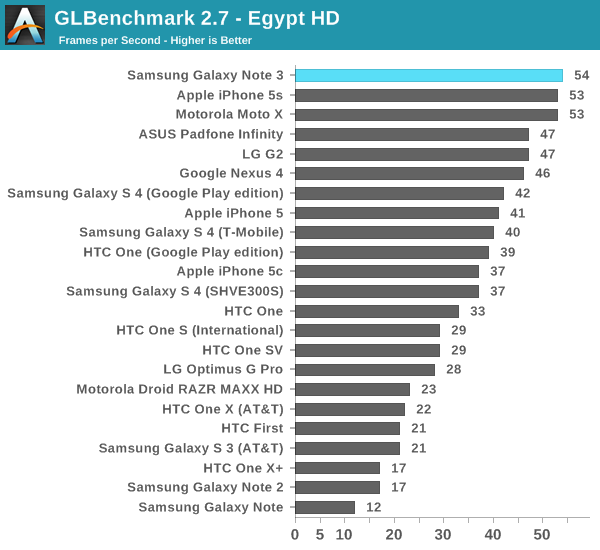
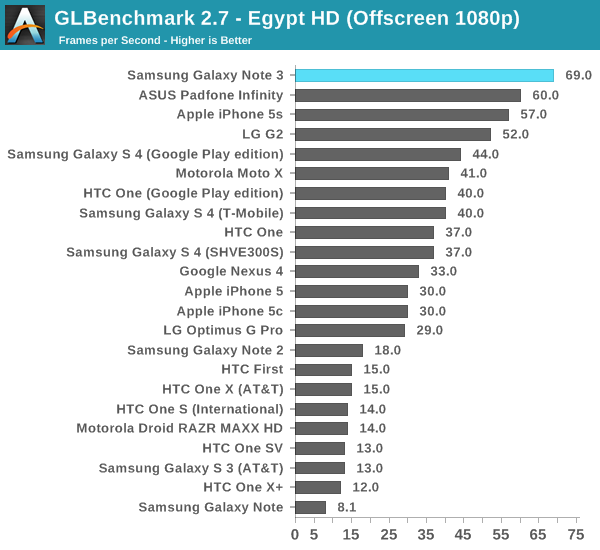
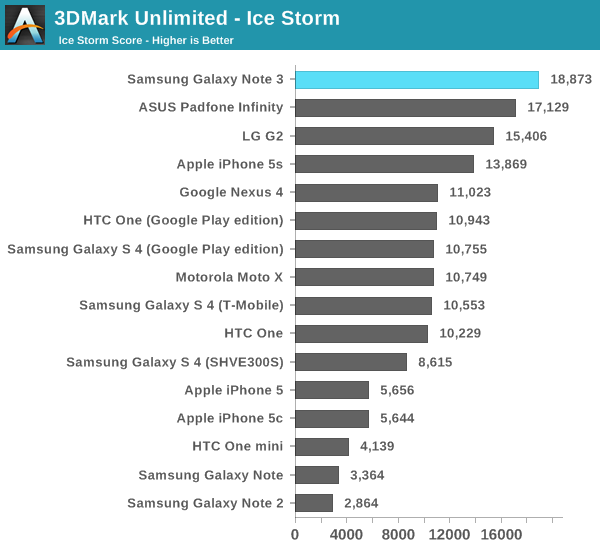
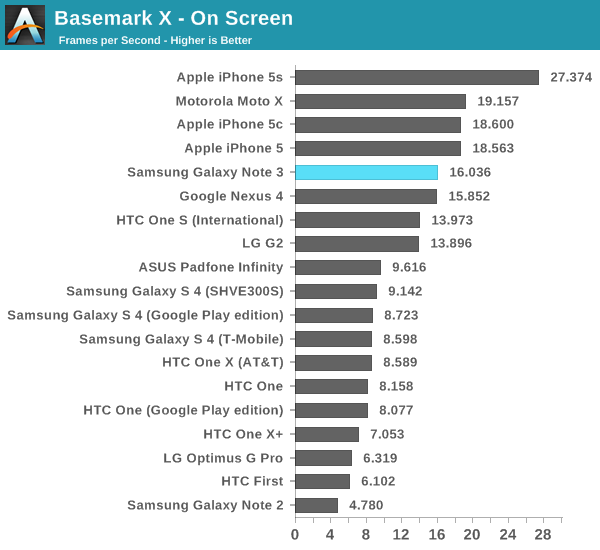
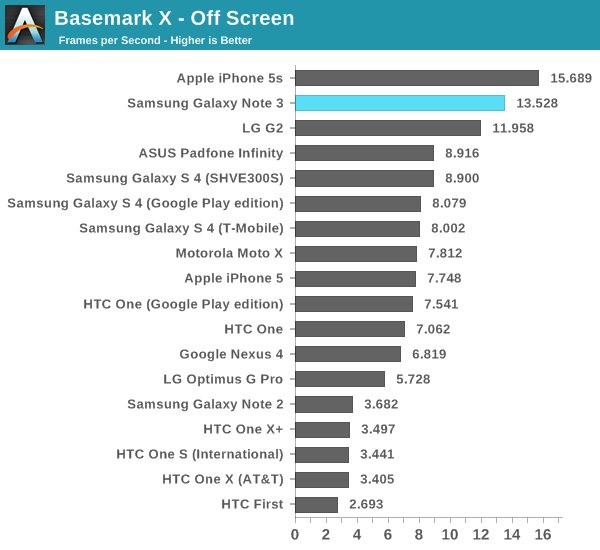

NAND & USB 3.0 Performance
Our Galaxy Note 3 review sample posted some incredible storage performance results, at least compared to all other Android smartphones we've tested. Sequential read and write performance are both class leading - the latter is nearly 2x better than the next fastest phone we've tested. Random read performance is decent, but it's random write performance that's surprising. Unlike the Moto X, the Galaxy Note 3 doesn't rely on a flash-friendly file system to get great random write performance - this is raw eMMC horsepower (if you can call ~600 IOPS that). The result isn't quite as good as what you get out of the Moto X, but it comes very close. Android 4.3 should bring FSTRIM support to the Galaxy Note 3, so as long as you remember to leave around 20% of your storage as free space you should enjoy relatively speedy IO regardless of what you do to the phone.
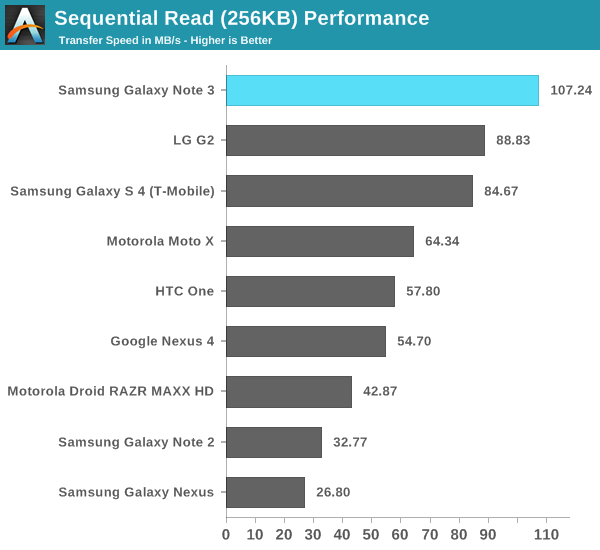
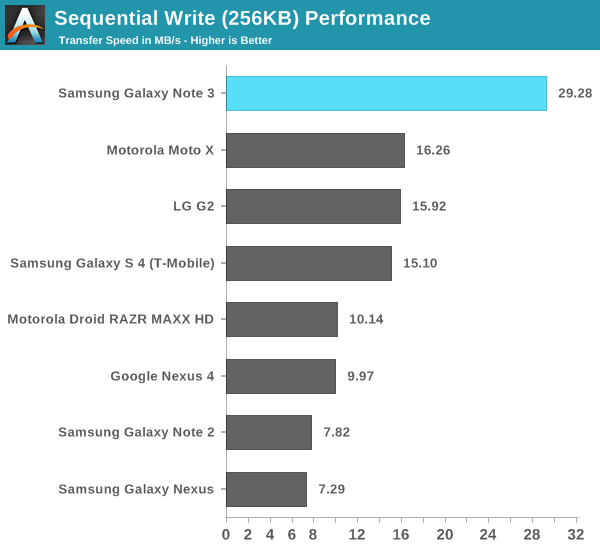
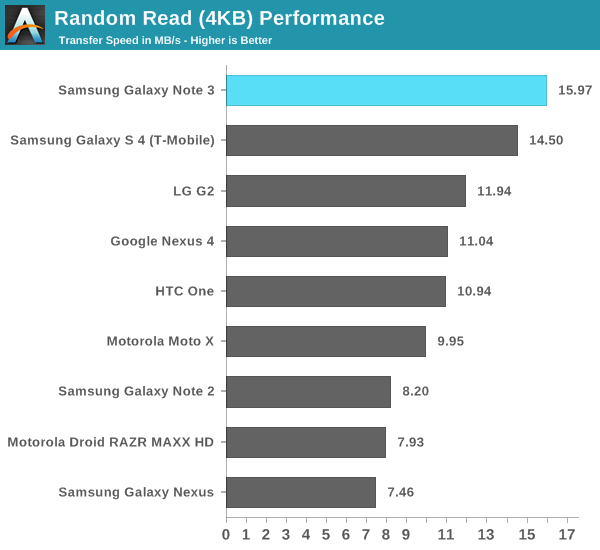

The Galaxy Note 3 ships with USB 3.0, unfortunately at least in its current state it doesn't seem to get any benefit from the interface. Although the internal eMMC is capable of being read from at ~100MB/s, sustained transfers from the device over adb averaged around 30MB/s regardless of whether or not I connected the Note 3 to a USB 2.0 or 3.0 host.
Update: USB 3.0 does work on the Note 3, but only when connected to a Windows PC with USB 3.0. Doing so brings up a new option in the "USB Computer Connection" picker with USB 3.0 as an option. Ticking this alerts you that using USB 3.0 might interfere with calls and data, but then switches over. Connection transfer speed is indeed faster in this mode as well, like you'd expect.
It only appears on Windows as well, my earlier attempts were on OS X where this popup option never appears.



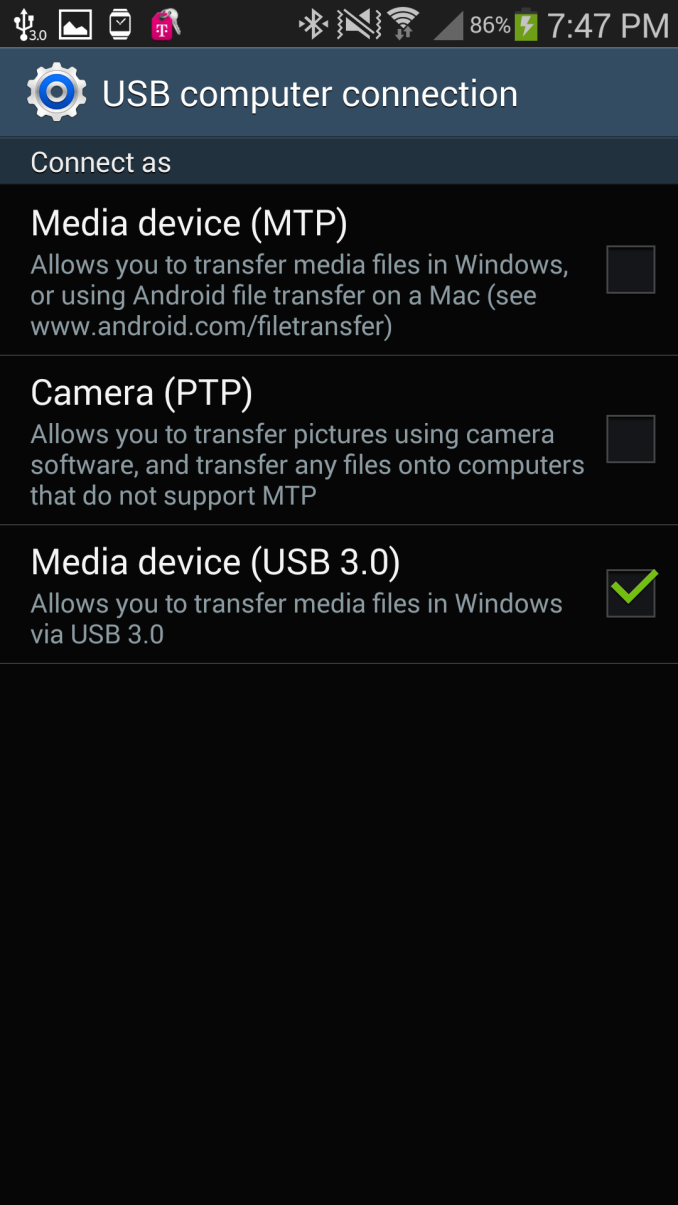
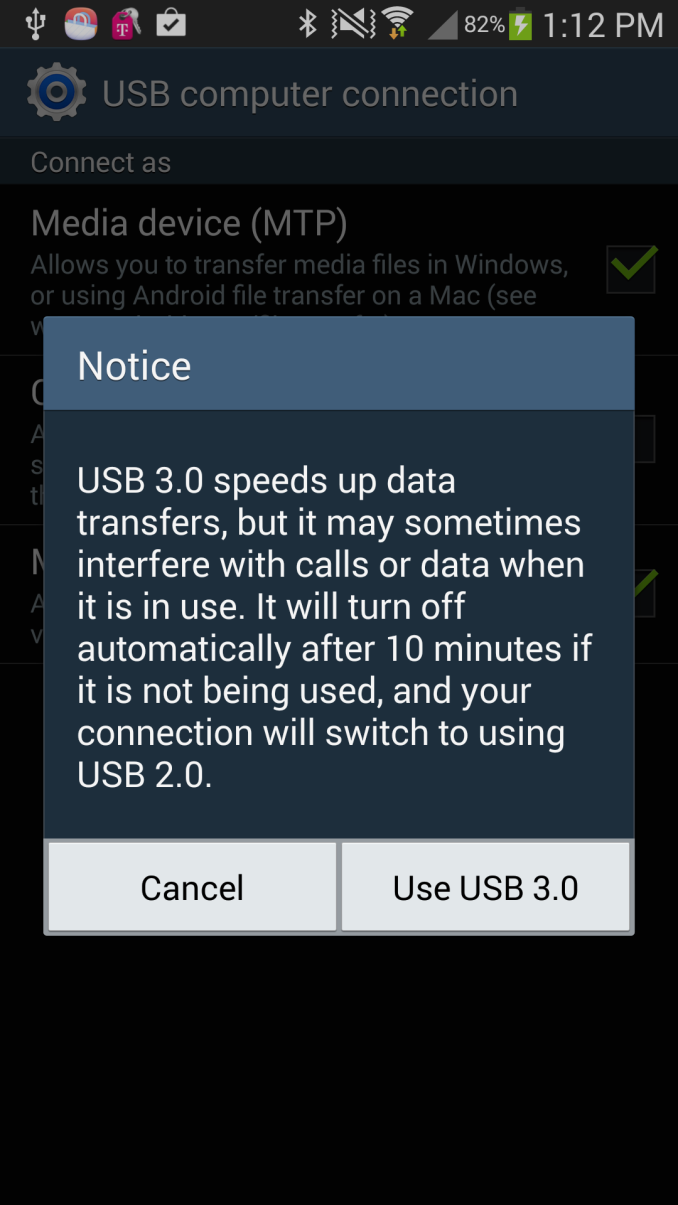








302 Comments
View All Comments
risus - Monday, October 7, 2013 - link
I agree with apiljack80. I would actually like to see this supported with options to run with different loads, throttles, and tasks to simulate different types of real work and then also a boosted all out top score.What I don't care for is that Samsung was not forthcoming with this. Had they given the user to choose profiles they would have received a whole different,and I believe, more positive response. It's the whole reason why this is being labeled a "cheat" because the technical action is not a cheat at all.
But alas this is getting so much publicity and with some other phones adopting this I think we are headed for a profile labeled benchmark anyways. Scrutiny in the mainstream tends to have it's audiences aware and vocal. But for my OC'ing (when avail for n3) I'm flipping on all cores, disable all power save, keep the thermal conservative and lets see how high we can get that bar!
AngryCTO - Thursday, October 3, 2013 - link
Besides the reviewer, how many people here actually played a bit with a Galaxy Note 3, before issuing opinions? I would advise anyone against purchasing a $650 phone without playing with it for a while. I have owned a Note 2 and felt reasonably certain to order a Note 3 without trying it in a shop before.30 minutes after I opened the box, I repackaged it and sent it back, because I find it very unpleasant to hold. Not because of the size, as some might say, but because the plastic/rubbery back feels dusty and I get the feeling I am getting my hands dirty just by holding it. The rim also feels edgy and looks like a very cheap third rate Chinese thingy. Same for the pen. People do have the touch sense too, you know. But to see what terrible crap packaging Samsung is selling, you have to open the battery compartment, at which moment all pretensions of class disappear.
The phone does feel very fast and the image quality is pretty good. The software is so bloated it is confusing to use. If they could only fix their packaging attitude to use some premium materials and streamline the software.
Until then I am buying an Xperia Z Ultra, which is cheaper but has a much better display and looks. I will be much more careful with buying Samsung from now on.
ESC2000 - Monday, October 7, 2013 - link
You do know that you can replace the back of the note III, right? You arent stuck with the fake leather back.AngryCTO - Thursday, October 3, 2013 - link
This review bothered me so much, that it looks almost like paid advertising. It is abnormal to compare the specs of Note 3 vs older Samsung phones (page 1), and not include other competing phablets, such as Sony Xperia Z Ultra, HTC Max, Nokia 1520 (which is going coming out this October). Of course, Xperia Z Ultra would wipe the floor with Note 3 with its build quality and superb glass covering, not to forget that Triluminos is the best screen technology on the market right now (and larger). This while Lumia 1520 would provide a much better and saner software experience to the overbloated TouchWiz GUI. Of course, the reviewer totally skipped the Software and User Experience part of the review, but he did compare the CPU and luminosity of such "stalwarts" like HTC One X, which is 18 months old. I could not discover in the entire review any negative comments, neither any suggestions for improvements. This phone looks perfect in the review, which is not, as I very well know after returning one. Having done my shopping research as well as possible for purchasing such an expensive phone, I would not compare a phablet with anything else but a phablet. This review is lacking competitive comparisons and relevancy.wales - Thursday, October 3, 2013 - link
Brightness Question.I've been looking for comments on this and became exhausted by the repetitive cheating discussion and gave up, so forgive me if I missed it. Brightness (or lack thereof) has always been a concern with Samsung and AMOLED displays when compared to LCDs like the HTC One, LG and IPhones. The lack of visibility outdoors in particular has been a dealbreaker for some. So I was surprised that it wasn't even mentioned in the review. Only a chart was given, showing the Note 3 well down the list at 326 nits, making it one of the only specs that may steer you away from the phone.
If that was it I'd just conclude, "ok, brightness still sucks," but a detailed display review from Displaymate comes to the opposite conclusion and touts the far superior brightness of the Note 3 compared to the Note 2. (link: http://www.displaymate.com/Galaxy_Note3_ShootOut_1... It even gets measurements of 628 nits in movie mode(!). That is a "peak brightness" measurement that Anand does not perform and may be meaningless, but the Displaymate review does note that by checking the automatic brightness box the display is capable of far higher brightness in high ambient light (i.e., sunny outdoors) environments. If true, this would largely dispel the concern with using the Note 3 outdoors, a concern reinforced by the low brightness measurement in the Anandtech review.
Anand or Brian, can you repeat the brightness measurement using automatic brightness? That would seem to be key information and potentially much more relevant than a measurement without automatic brightness checked. I understand why you would not generally take this approach, because checking auto brightness will often cap the brightness level rather than unleash it, but in this case Samsung may have reversed the approach.
If I'm off on this and Displaymate's data is wrong, my apologies.
diendanforex - Thursday, October 3, 2013 - link
The success of the Galaxy Note has increased our belief that consumers want to experience the high-quality features on the devices more intelligent and that their lives become better . Dien dan forex: http://fxvnol.comDavidjan - Thursday, October 3, 2013 - link
Cool! it must support Meenova reader to add storage like other Galaxy phone: http://goo.gl/U6IyYmeliketrolls - Friday, October 4, 2013 - link
Apple does better things than Samsung.iOS is soooo much better than Android.
josephandrews222 - Friday, October 4, 2013 - link
...all of these comments by in-hiding Apple guys are (unintentionally) revealing--the Note 3 must be, in their minds, a really good phone.Full disclosure: I do not own either an Android phone or an Apple phone
rampantarmadillo - Friday, October 4, 2013 - link
Anyone have one of these and know whether it has opengl es3 support?